July 20, 2021 – Volume 23, Issue 7
In This Issue
-
Flanigan’s Eco-Logic: The EV World
- Electric Pick-Up Trucks Ready for Blast Off!
- Mash-Up: Spent Blades / Gravitational Storage
- Extended Producer Responsibility
- Decarbonizing Europe Fast
- GM Greening Suppliers & Customers
- Corporate PPAs and Hourly Load-Matching Strategies
- Microgrids 1.8: Let’s Discuss Generators
- Recent Episodes of The NetPositive Podcast

Flanigan’s Eco-Logic: The EV World
The EV world is rich in developments: There’s a cacophony of new EVs on the market, from cars, to trucks, buses, trains, planes, and ships. EVAdoption reports that there are currently 56 plug-in electric and battery-electric vehicles available in the United States. PlugStar by Plug-in America shows 28 all-electric models available in the LA market.
The action is broad and in line with a global movement to decarbonize. EVs powered by renewables make decarbonizing transport possible. Policies are catalyzing markets which are going berserk! There are lots of new market entrants; car and now pick-up providers with names we’ve never heard before: Rivian, Lordstown Motors, Atlis, Hercules, Canoo, Flicker, and Alpha Wolf.
Just this morning came the news that the German government will increase the value of its incentives and extend its incentives for EVs for another four years, until 2025. Good news. The incentives are now worth ~$10,000 for a Model 3 Tesla, with a third paid by the automotive industry as previously negotiated. The announcement boosted stock prices for EV manufacturers including Tesla and Volkswagen.
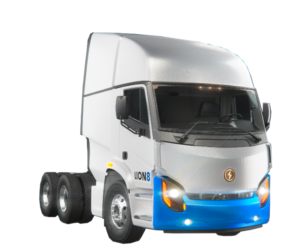 EVs come in all shapes and sizes. I am so impressed by the Lion all-electric Class 8 trucks! Lion also makes school buses. Much smaller, the MEV is a 100% electric compact urban commuter from Europe. It can be configured either as a cargo box van or pick-up. It accesses small parking spaces and comes in six standard colors. MEV, a leader in golf carts since 2005, has hit the streets of London with its basic, 100-mile range EVs.
EVs come in all shapes and sizes. I am so impressed by the Lion all-electric Class 8 trucks! Lion also makes school buses. Much smaller, the MEV is a 100% electric compact urban commuter from Europe. It can be configured either as a cargo box van or pick-up. It accesses small parking spaces and comes in six standard colors. MEV, a leader in golf carts since 2005, has hit the streets of London with its basic, 100-mile range EVs.
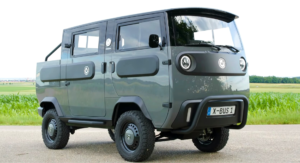 In Germany, Electric Brands is showing off its Xbus, what one enthusiastic critic called “absolutely adorable.” By legal definition in Europe, the Xbus is not an automobile, but instead it’s in the L7e class of heavy quadricycles. That’s a new compact class endorsed by local authorities in Europe for their environmental benefits and use in rural and urban areas. Xbus has a top speed of 62 miles per hour and a 10 kWh battery which gives it a range of 124 miles. The Xbus has drawers for swapping out batteries to quickly recharge.
In Germany, Electric Brands is showing off its Xbus, what one enthusiastic critic called “absolutely adorable.” By legal definition in Europe, the Xbus is not an automobile, but instead it’s in the L7e class of heavy quadricycles. That’s a new compact class endorsed by local authorities in Europe for their environmental benefits and use in rural and urban areas. Xbus has a top speed of 62 miles per hour and a 10 kWh battery which gives it a range of 124 miles. The Xbus has drawers for swapping out batteries to quickly recharge.
Move over Tesla! Porsche, Ferrari, and others are moving into the EV space: Porsche with market domination, Ferrari with high performance electric in the forefront. Barron’s reports that Ferrari’s stock has surged forward– that it is spending aggressively on 21st century EV technology. (Ferrari is also reportedly “accepting the inevitable,” making a Ferrari SUV. Porsche, Lamborghini, Maserati, Aston Martin, Rolls Royce, and Bentley all already make these SUVs. Someday they will be all-electric!)
Porsche Automobile Holding is a holding company that consists mainly of its controlling interest in Volkswagen (VW), which has divisions including Porsche and Audi. Porsche also owns luxury names including Bentley, Lamborghini, and Bugatti. Porsche also has the goal of being the #1 EV leader in the world by 2025, surpassing Tesla.
Recently, VW introduced the IE.4 SUV, its first EV designed from the ground up. It is designed to compete with the Chevy Bolt and the Ford Mustang Mach E EV, both in the $40,000 price range. All of three undercut the $50,000 price tag for the Tesla Model Y. At the other end of the spectrum, Porsche’s Taycan EV can be configured either as a sedan or SUV, and is priced at $80 – 190,000.
Quote of the Week
“Think of it like Costco; you go there and buy in bulk.”
Electric Pick-Up Trucks Ready for Blast Off!
Lots of press for astronauts Richard Branson and Jeff Bezos! Well, electric pick-ups are ready for blast-off too! Which all-electric pick-up truck will enter the market first? According to experts at InsideEVs, the Rivian R1T will win, followed closely by Tesla’s Cybertruck and the Lordstown Endurance. We present four, all-electric trucks likely to be available in 2021, and 10 more in the next three years.

Rivian R1T
Our friend and energy-efficiency expert/colleague, Chris Caldwell, has a deposit on the Rivian R1T. It has a 300-mile range and a price of $67 – 100,000. Other 2021 EV pick-ups include Tesla’s Cybertruck. It boasts the “performance of a sports car,” plus a range of 500 miles for $39 – 69,000. The Lordstown Endurance features four, in-wheel motors for propulsion. It has 250 miles of range and costs $52,000. Another 2021 release is the Bollinger B2 with 200 miles of range for $125,000.
There are also more EV pick-ups in the wings. In 2022, the GMC Hummer EV electric pick-up truck will be released. It has a range of 350 miles and starts at $112,000. The Ford F-150 Lightning, which features home emergency power, has 230 – 300 miles of range, and a price tag of $39 – 90,000. The 2022 Chevrolet Silverado is slated to have 400 miles of range, but its release date and price details are unknown. The 2022 Atlis Xt will have 500 miles of range at a cost of $45,000. The Hercules Alpha is slated to get 300+ miles of range, has an unknown price, but is accepting $1,500 deposits. Other all-electric pickups in the works for release in the next few years include the Fisker Alaska, Nissan Titan Electric Truck, Canoo Electric Pickup Truck, and Alpha Wolf.
Some say that the RAM 1500 BEV is behind the pack. With 159 – 200 kWh battery packs and up to 500 miles of range, its all-electric pick-up production is slated to start in 2024. RAM is also planning to produce a mid-sized pickup. By 2025, RAM intends to offer a fully electrified solution in a majority of its segments, and in all segments no later than 2030, which means multiple electric trucks and vans. RAM is now part of Stellantis, a Dutch-domiciled, multinational automotive manufacturing corporation formed this year, based on the $52 billion merger between Fiat Chrysler and the French PSA Group. It is headquartered in Amsterdam.
Mash-Up: Spent Blades / Gravitational Storage
What to do with old wind turbine blades? They are becoming a major source of solid waste, and as such, EcoNet has reported on recycling initiatives that are underway. One new idea to address this major solid waste issue is presented by Energy Vault, a Swiss company that is in the gravitational storage business. It proposes to use the aging blades that used to generate power, and to form them into 35-ton blocks for its energy storage systems.
The mash-up will give new life to old blades, a positive circular economy. The blades last about 20 years. One expert noted that “a flood of spent blades” is about to hit the global market. Recycling is possible but complex. Energy Vault has an elegant solution: How about forming them into blocks for gravitational storage? Energy Vault’s gravitational storage systems harness excess wind or solar power to raise something heavy upwards. The blocks! They then release the heavyweights during peak periods. The storage benefits are the same as pumped storage, but at a lower cost, and the gravitational storage systems can be replicated anywhere as they have no geographic limits. Unlike batteries, the storage blocks are inert… there is no storage medium degradation, and unlike batteries, there is no risk of fire.
Updates: Energy Vault has built a 5 MW demonstration of its system. Enel Green Power now plans to commercialize the technology. A new Energy Vault design requires 40% less height. For an upcoming facility, Energy Vault has signed an agreement to use spent wind turbine blades to form the blocks.
Extended Producer Responsibility
 The State of Maine became the first state in the nation to require companies that create consumer packaging to pay for the costs of recycling it. Governor Janet Mills signed a bill on July 13th that establishes the “Extended Producer Responsibility (EPR)” program. The legislation will charge large packing producers for collecting and recycling cardboard boxes, plastic containers, and other packaging materials, plus the disposal of non-recyclable materials. Income generated will support local recycling efforts that heretofore have had to rely on taxpayer dollars to fund their operations.
The State of Maine became the first state in the nation to require companies that create consumer packaging to pay for the costs of recycling it. Governor Janet Mills signed a bill on July 13th that establishes the “Extended Producer Responsibility (EPR)” program. The legislation will charge large packing producers for collecting and recycling cardboard boxes, plastic containers, and other packaging materials, plus the disposal of non-recyclable materials. Income generated will support local recycling efforts that heretofore have had to rely on taxpayer dollars to fund their operations.
Across the country, ten states, including New York and California, have considered similar legislation. In Oregon, a similar EPR bill awaits the governor’s signature. EPR has been put in practice in Europe and in several Canadian provinces, including Maine’s neighbor, Quebec. Many states already have EPR programs for hard-to-dispose-of items such as batteries, mattresses, and medicines.
Maine has a reputation for leading on environmental causes. It passed one of the first bottle bills in the 1970s. Twenty years ago, it passed a law requiring manufacturers to pay for the recycling of electronics, including computers and televisions. In 2019, Maine passed a ban on foam food containers.
Decarbonizing Europe Fast
 The European Union is pushing hard on climate protection. This week’s drastic flooding made the urgency clear. The EU’s European Green Deal was approved in 2019 and calls for Europe to be carbon neutral by 2050. It recently released the “impact assessment plan” for its branded “Fit for 55” initiative. Fit for 55 presents a roadmap for achieving an even steeper 2030 emissions reduction target, up from 50% to 55% from 1990 levels. That’s less than the recently announced United Kingdom target of 68%, but more rigorous than the United States target of 40 – 43%.
The European Union is pushing hard on climate protection. This week’s drastic flooding made the urgency clear. The EU’s European Green Deal was approved in 2019 and calls for Europe to be carbon neutral by 2050. It recently released the “impact assessment plan” for its branded “Fit for 55” initiative. Fit for 55 presents a roadmap for achieving an even steeper 2030 emissions reduction target, up from 50% to 55% from 1990 levels. That’s less than the recently announced United Kingdom target of 68%, but more rigorous than the United States target of 40 – 43%.
President of the European Commission, Ursula von der Leyen, stated that the European Green Deal would be Europe’s “man on the moon moment,” making Europe the world’s first climate neutral continent. It will fundamentally transform the world’s largest trading bloc; it touches almost every area of economic activity.
Fit for 55 is a “comprehensive architecture” to meet the EU’s climate ambitions. It is indeed all-encompassing. Cars with internal combustion engines (ICE) will not be allowed to be sold by 2035. Electric utilities will have to speed the adoption of renewables. Steel and cement producers will have to pay for every ton that their factories emit. Cargo ships will not be able to dock at Rotterdam or Hamburg unless they run on clean fuels. Airlines will be required to use synthetic fuels produced with green energy. The plan calls for planting 3 billion trees.
Fit for 55 calls on each of its 27 member states for action. It rolls out a vision for a future without carbon. It includes financial incentives, notably for EV charging stations. It includes $890 billion to help farmers, small businesses, and low-income households make the transition to cleaner energy. Both the U.S. and China will be penalized for imports produced with lower environmental standards. Now the plan needs approval, first from the European Parliament, and then from each member state, a process that is anticipated to take two years.
GM Greening Suppliers & Customers
![]()
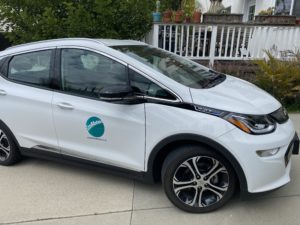 General Motors has a commitment to be carbon neutral by 2040. The commitment is even broader than transitioning its products to be electric vehicles. It’s also about greening its operations and its supply chain, those industries that make its parts.
General Motors has a commitment to be carbon neutral by 2040. The commitment is even broader than transitioning its products to be electric vehicles. It’s also about greening its operations and its supply chain, those industries that make its parts.
To accomplish its goal, GM has formed a partnership with Shell and its subsidiary MP2 Energy to offer its suppliers in Texas the ability to buy renewable power at a discount. Through this bulk purchasing initiative, suppliers will be able to buy 100% green at no additional cost. Texas is where many of GM’s trucks and SUVs are manufactured.
GM has already committed to invest $35 billion in electric and autonomous vehicles by 2025, and recently established a $25 million Climate Equity Fund to help close the equity gaps in the transition to electric vehicles. A logical partner, Shell has long been one of the largest wholesale traders of energy. Its portfolio includes renewable energy.
GM also offers a similar program for its customers. Some 500,000 GM vehicle owners in Texas have been invited to sign up for renewable home energy plans through MP2. The plan provides the perk of free overnight EV charging. You don’t, however, need to have an EV to participate in this green energy bulk purchase program, just a GM vehicle.
Corporate PPAs and Hourly Load-Matching Strategies
Power purchase agreements are routinely used by power consumers — such as schools and public facilities — to purchase green power. A third party — PPA developer — installs, owns, and operates the renewable energy system, selling its output to the customer. This can happen on-site, for instance through solar financed and developed by a PPA developer, or through a “virtual PPA” or a “synthetic PPA,” where the customer purchases Renewable Energy Certificates to complement and green local power purchases.
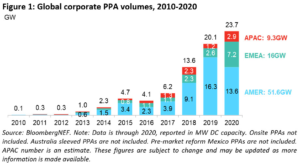
Courtesy of BloombergNEF
I was shocked to see the uptick in PPAs being used by corporate America as presented by Bloomberg NEF. For some years, PPAs have been a most attractive tool for non-profit entities that have no tax appetite, and thus cannot monetize either the investment tax credit or the accelerated depreciation benefits. In the past few years, however, there has been explosive growth of corporate PPAs — a no-money-down means to save money and achieve corporate sustainable development goals (SDGs). Worldwide, there was 23.7 GW of corporate PPA capacity in 2020; there was 20.1 GW in 2019. These values compare to less than 1 GW in 2012.
In related news, Rocky Mountain Institute (RMI) has prepared a report supported by Microsoft that focuses on hourly load-matching strategies for large corporations that are keen to green their operations. Many corporations and solar enthusiasts (like myself) may be boasting 100% green power use. Given the intermittent generation of renewables, however, we likely are not actually getting renewable energy all the time. While you produce 100% of your onsite load on an annual basis, at certain times of the day and night, some of the actual electrons flowing to your facility or home are likely from natural gas, nuclear, and perhaps coal.
You have to look at local grid characteristics, says the RMI report, to ensure 24/7 renewable energy. It’s all about timing and coupling renewable resources strategically. The report examines seven regional electricity markets, including four in the United States. Microsoft and Google are among a few large companies that have piloted hourly load-matching strategies.
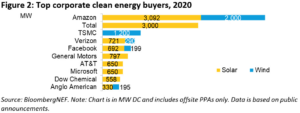
Courtesy of BloombergNEF
Microsoft has purchased renewables to offset the emissions from its operations since 2012. Now it has a new goal. By 2030, Microsoft wants to make sure that it is powered by clean energy round the clock. With Adobe, Google, Hewlett Packard, and environmental groups, Microsoft sent a letter to President Biden advocating for policies that support “higher-impact electricity procurement” means to source renewable energy 24/7.
Microgrids 1.8: Let’s Discuss Generators
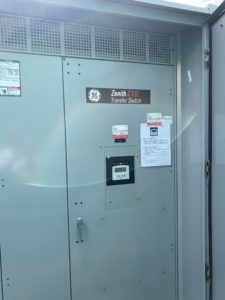
Transfer switch for an emergency backup generator at a municipal facility
This is the eighth article on microgrids… a technology so pertinent to the times. Much of the West is currently on fire, and as a result, energy resilience is top of mind and of paramount importance for many facilities and homes. EcoMotion specializes in solar + storage + microgrid control solutions… with resiliency works now involving key facilities in ~30 cities.
In many of the municipal facilities that our teams are evaluating for solar + storage, there are already generators. So, do these facilities fit into an energy resilience program? Are they covered already? Do generators complement solar + storage, or must these facilities forgo any opportunity for renewable, zero-carbon resilience?
Generators have been used for decades for critical facilities such as hospitals, police stations, pumping stations, fire stations, etc. They often run on diesel fuel, are closely regulated by local air quality control boards, and need to be routinely tested. For those that run on diesel, the generator provides resilience for as long as there is fuel in the tank. Other generators are hooked up to natural gas lines… which fail in emergencies only 5% of the time that electrical grids fail. Some natural gas generators are now backed up with propane tanks. Again, a finite amount of fuel.
Solar + storage microgrids are more costly, complex, and limited in some ways, but have a huge advantage in terms of fuel. Solar keeps on giving. So, as long as we can design microgrids that manage onsite energy use during emergencies to match the facility’s loads with the amount of incoming solar— buttressed with storage of course—the solar + storage microgrids can operate indefinitely and carbon-free.
EcoMotion is working with many Southern California cities now that have generators. Given their climate protection goals, they are keen to call on solar first and revert to “normal” generator back-up only as needed. This protocol can drastically cut the carbon footprint… alleviating greenhouse gas emissions that exacerbate the climate crisis. This is not only beneficial to the fight against climate change, but also to our air quality as diesel generators emit particulate matter that contains over 40 toxic air contaminants, in addition to greenhouse gases. If we can prove the carbon-free model, then the generators can ultimately be retired.
But wait! A hugely powerful case can be made to integrate existing generators into microgrids. As we all know, one of the drawbacks of variable solar energy is that we cannot always predict the extreme outlier cases when solar production is at its lowest. We begin sizing solar and battery systems by looking at averages, not extremes— average solar production in a given location and a facility’s average load. To size a system to cover those most unlikely cases—the toughest 2% of the time – requires investing huge amounts of money in equipment that is rarely needed. Generator capacity is a fraction of the cost of solar capacity.
Those times when solar + storage cannot provide enough capacity is when generators can be useful. By relegating the generator’s use to only those most critical periods, run times can be drastically diminished, and solar and storage system sizes can be reduced. For this reason, generators are currently being specified by some developers for new microgrids. They can be remarkably well — and precisely — integrated into a microgrid’s operations.
The existence of a generator at a facility can also cut down on solar + storage installation costs in some cases because the facility may already have a transfer switch, or potentially even electrical wiring with subpanels for critical loads. The existence of the battery allows you to run the generator at full throttle (at a fixed output), instead of ramping up and down to meet loads, because any excess generation can be stored in the battery. This allows the generator to run most efficiently and for shorter periods.
For many of us, any carbon emissions are unacceptable. Thus we have an immediate concern about the use of generators. Our concerns are elevated when it comes to making investments in infrastructure that supports a fossil-fueled power structure. But here’s a means to maintain the highest levels of reliability in a solar + storage microgrid, for hospitals, police facilities, and other critical facilities. Generators allow for these levels of reliability without incurring inordinate battery storage costs. Thus a case can certainly be made that the infrequent and precise use of a generator can make tremendous sense.
Recent Episodes of The NetPositive Podcast
 Convo: Peter Asmus on Microgrids and the Changing Utility Landscape:
Convo: Peter Asmus on Microgrids and the Changing Utility Landscape:
Peter Asmus is a Research Director at Guidehouse Insights, the firm that recently acquired Navigant Research where Peter worked for a decade. An investigative reporter and seasoned researcher, he provides valuable insights and perspectives on microgrids and the changing utility landscape. Peter discusses the genesis of microgrids in the developing world, shunned in Europe where reliability has never been an issue, and microgrids in America, notably California, given concerns about PSPS events and wildfires. Peter covers microgrid issues including utility culture, interconnection, generators, modular UL-approved systems, and energy as a service, fully financed and operated systems with no upfront capital costs.
Note also that this issue of EcoNet News is also available in audio form. Check out The NetPositive News:
